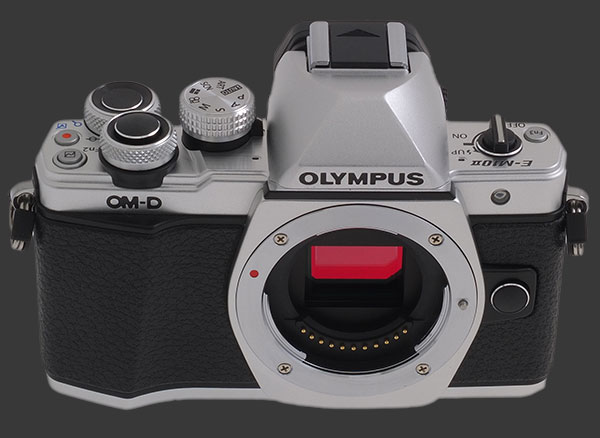Olympus OM-D E-M10 Mark II Review
Olympus OM-D E-M10 Mark II Performance - How well does it take pictures?
Performance starts with image quality, which is the criteria used as the foundation of our digital camera ratings. Ergonomic issues may get in the way, but in the end, image quality counts the most. For an ILC, image quality greatly depends on the lens used. While color, noise, exposure and dynamic-range are properties of a camera, distortion, vignetting and chromatic aberrations are properties of the lens. Sharpness and contrast depend on the weakest link. That is, a camera cannot capture more details than a lens lets through. Conversely, it is quite possible for a lens to transmit more details than a sensor can capture.

Image Noise & Details
The Olympus OM-D E-M10 Mark II delivers very good image quality, even exceeding its mid-range sibling due to an improved processing engine and having no anti-alias filter. It shows impressive sharpness when combined a high-quality lens such as those in the M.Zuiko PRO series.
Image noise is extremely low until ISO 1600 and barely there at 3200 where it remains usable for relatively large prints. ISO 6400 produces more visible noise which damages the finest details and reduces maximum print sizes by a few inches. There is a notably jump in noise at ISO 12800 where fine details become really muddy. Once can still produce a reasonable mid-size print though, it just will not hold up to close scrutiny.
The maximum expanded sensitivity of 25600 shows another leap of image noise. Details are truly gone but subjects stay recognizable with contrast and colors remaining remarkably intact. Small prints or images resized for web usage are still possible even at ISO 25600 which is really good.
There are three levels of noise-reduction available. NR can also be turned off entirely which avoids increased softness at high sensitivities. Best results are obtained with the NR Off and Sharpness at its default. Anything higher shows clear sharpening artifacts on this camera.

Color & White Balance
The OM-D E-M10 Mark II has improved color accuracy compared to its siblings. It offers many Picture Modes modes with he most realistic colors are obtained in Natural style with Saturation pushed +1. That still leaves a little too much red but this has been typical of Micro Four-Thirds cameras. It is obviously avoidable for those who shoot RAW.
Automatic While-Balance is excellent. It deals well with a variety of conditions including typical indoor lighting. There are tons of options for the rare cases when AWB has difficulty or to get consistent colors between shots. Custom WB is easy to use on this camera and renders whites perfectly neutral.
Exposure
This digital camera has a well-balanced multi-segment metering system. It is nicely conservative and overexposes only when bright highlights are small or away from the center of the scene. Scenes of high contrast tend to get clipped more in the shadows than highlights which is usually the better choice. Low contrast scenes are exposed towards the mid-tone which makes them look natural.
It is important to know that the LCD clips extreme highlights which may still be correctly captured. This happens when adjusting the highlight tone-curve too. Differences are barely noticeable on the LCD but images are in fact captured differently. Changes to the shadow tone-curve are much easier to see. When in doubt, the Playback histogram must be checked. The Live-Histogram is only truly accurate in M mode.
Dynamic range of the E-M10 Mark II is fairly good across its standard range of ISO sensitivities. ISO 200 delivers the widest dynamic-range since that is the native sensitivity of the sensor. Still, sensor size is unforgiving and this Micro Four-Thirds mirrorless is unable to match the broad dynamic-range of systems with larger sensors.
For even more dynamic-range, there are 2 HDR modes built-in to the E-M10 Mark II, both take 4 consecutive shots and blend the resulting exposures together. The steps appear to be somewhat wider in HDR 2 mode than HDR 1. Results are generally good, although it has difficulties with light sources in the scene. One limiting factor though is that the camera locks ISO to 200 when built-in HDR is enabled. Manual HDR is always possible for more flexibility since this camera allows AEB with up to 7 frames.

Auto Focus
The OM-D E-M10 Mark II has a speedy Contrast-Detect autofocus system. Its autofocus speed compares to a mid-range DSLR at any light level. Focusing accuracy is extremely high. Plus, unlike Phase-Detect AF used in DSLRs, Contrast-Detect AF never suffers from front or back focus issues, which is why no calibration is needed.
With a typical Micro Four-Thirds lens, focus is done via a fly-by-wire ring around the lens-barrel. The E-M10 Mark II manages to keep up with no perceptible lag. In DMF mode, a slight turn of the focus-ring shifts right into manual focus. When the focus-ring is fly-by-wire, the E-M10 Mark II can reverse the rotation to adjust focus. For a lens such as the M.Zuiko 12-40mm F/2.8 PRO though, the focus-ring can be switched from fly-by-wire to mechanical mode. Reversing the focus rotation affects the former but not the latter, so it may get confusing.
Normally, when a camera is switched from AF to MF, the focus distance does not change. This lets the photographer use autofocus to lock focus and switch to manual focus when take a series of shots to combine later, either for HDR, Exposure Fusion or Panoramic Photography. With the Olympus mechanical focus-ring lens though, the focus gets reset to the last manually set distance, meaning that a series of frames must nearly always be manually focused from the start.

Speed
The E-M10 Mark II is quick and responsive. Buttons, dials and the Eye-Start sensor all respond instantly. Despite being entry-level, this OM-D delivers a speedy 8.5 FPS at full resolution. It can capture up to 36 JPEG images or 22 RAW files in a single burst. This is with autofocus locked on the first frame. In continuous autofocus mode, the E-M10 Mark II can shoot indefinitely at 3.5 FPS.
The Olympus OM-D E-M10 Mark II rarely holds back the photographer. The following measurements characterize its performance:
- Power-On: ¾s. Nice.
- Power-On to First-Shot: 1½s. Good.
- Autofocus: ¼s on good to moderate light. Rarely more than ½s, even in low light. Excellent.
- Shutter-lag: Nearly instant with around ¼s blackout. Very good.
- Shot-to-shot: Under ¾s. Much faster then the average mirrorless.
- Playback: ½s to enter, instant to exit. Excellent.
- Power-Off: 1s. Average.
- Video: 1s to start, instant to stop. Slow.
Overall, the E-M10 Mark II turns in a solid performance. It does particularly well where it counts most: shutter-lag, autofocus and shot-to-shot speed. For video, it starts recording one second too late. This is the one regression compared to the original E-M10 which is unfortunate for videographers. The 8.5 FPS continuous drive works incredibly well though. The most significant regression compared to its siblings is that this camera no longer manages to keep the EVF or LCD up to date during continuous shooting.
The Olympus OM-D E-M10 Mark II is powered by a proprietary Lithium-Ion battery which provides 320-shots per charge with 50% flash use. This is below average among mirrorless yet should be enough for a day of casual shooting. For professionals, additional batteries are highly recommended.
Olympus OM-D E-M10 Mark II Conclusion

The Olympus OM-D E-M10 Mark II slots itself as the base OM-D model. Like its siblings, this mirrorless digital cameras features a built-in EVF with Eye-Start Sensor and dual control-dials, giving it professional controls and ergonomics. In achieving its reduced size and price-point, relative to other OM-D, the E-M10 Mark II forgoes weather-sealing. This marks it as an enthusiast model, rather than a professional one.
This advanced mirrorless is packed with features while remaining nicely compact. Its 16 megapixels Four-Thirds CMOS sensor omits the usual anti-alias filter to maximize lens sharpness. Combined with the TruePic VII processor, the E-M10 Mark II delivers images with excellent retention of details and good dynamic-range. Image noise is incredibly low until ISO 1600 and minimal at 3200. Noise increases progressively from there yet this camera manages to keep dynamic-range, contrast and color quite consistent.
Multi-segment metering of the E-M10 Mark II is really good. It produces reliable exposures that rarely need much compensation. While white-Balance is excellent, colors are not perfect yet remain quite acceptable. For critical work, there is always support for RAW capture which gives more latitude and flexibility at the expense of effort.
One aspect which has long differentiated Olympus mirrorless from others is in-body image-stabilization which benefits all lenses, even those adapted from other mounts. The Olympus OM-D E-M10 Mark II is equipped with the latest stabilization system, one which can compensate for movement along 5-axis: Horizontal, Vertical, Roll, Tilt and Pitch.
The E-M10 Mark II is usually quite speedy. It shoots continuously at 8.5 FPS, although the EVF does not quite manage to keep up with action which is a shame. The Contrast-Detect AF system of this digital camera is fast and remains so even in relatively low light. Video performance falters though with a one second recording delay. While the E-M5 Mark II has an unusual 8 second limit when recording 1080p at 60 FPS, the E-M10 Mark II does not. It even features a 30 FPS All-Intra mode which allows more efficient video editing.
The Olympus OM-D E-M10 Mark II may be the smallest OM-D, yet it fits right into the family with a very extensive feature-set, durable build and dual-control dials plus a built-in 2.4 megapixels 0.45" EVF with 0.62X magnification and 100% coverage. It delivers the best image-quality from a Four-Thirds sensor yet. Outside of some ergonomic quirks, there is really not much to dislike about this mirrorless. Being so compact, the Olympus OM-D E-M10 Mark II makes a superb digital camera for travel or any other type of photography where size and weight are crucial.
 |
Please Support Neocamera
All information on Neocamera is provided free of charge yet running this website is a huge endeavor. Purchases made via affiliate links found throughout the site help keep it running and up-to-date. There is no additional cost to you, so please consider buying via these links to our affilates:
If you found any information on this site valuable and did not purchase via our affiliate links, please considering donating via PayPal:
Any amount will be greatly appreaciated. Thank you for your support!
Olympus E-M10 Mark II Highlights

Sensor-Size: 17 x 13mm

Actual size when viewed at 100 DPI
| 16 Megapixels Mirrorless | ISO 100-25600 |
| Micro Four-Thirds Mount 2X FLM | Shutter 1/16000-60s |
| 5-Axis Built-in Stabilization, 4-Stop Improvement | Full manual controls, including Manual Focus |
| 0.45" Built-in EVF 2.4 Megapixels (0.62X) | Custom white-balance with 2 axis fine-tuning |
| Automatic Eye-Start sensor | Spot-Metering |
| 2 Axis Digital Level | Hot-Shoe |
| Built-in Dust Reduction | Lithium-Ion Battery |
| 8.5 FPS Drive, 36 Images | Secure Digital Extended Capacity |
| 1920x1080 @ 60 FPS Video Recording | |
| 3" LCD 1 Megapixels |
Updates
2024.11.18

Best 2024 Photography Gifts for Every Budget
Great gifts for photographers and photo enthusiasts selected for every budget among the best products of 2024.
2024.08.07

Eye Protection Tips for Professional Photographers
The four main considerations for professional photographers regarding eyewear.
2024.07.14

Fujifilm X100VI Review
Flagship fixed-lens compact digital camera with a 40 MP sensor and Image-Stabilization, a first for the series. Retro design featuring dual control-dials, plus direct ISO, Shutter-Speed and EC dials. Its hybrid viewfinder can switch between EVF and OVF mode.
2024.05.09

Fujifilm GFX100 II Review
Flagship 102 Megapixels Medium-Format Mirrorless Digital Camera with 8-Stop 5-Axis IBIS, 8 FPS Drive, 8K Video and 400 MP Super-Resolution capture in a weatherproof and freezeproof body with dual control-dials and dual memory-card slots.
2024.04.03

Fujifilm X-T5 Review
Newest Fujifilm flagship boasting a 40 MP APS-C sensor, 5-axis IBIS with 7-stop efficiency, 15 FPS continuous drive, 6.2K Video capture, dual control-dials and dual SDXC UHS-II slots in a sturdy weatherproof and freezeproof body.
2023.11.20

Best Digital Cameras of 2023
Find out which are the Best Digital Cameras of 2023. All the new Mirrorless Digital Cameras from entry-level to high-end professional.
2023.07.10

Fujifilm X-H2 Review
40 Megapixels APS-C Hybrid Mirrorless Digital Camera with 7-stop IBIS. Fastest shutter ever and 8K video capture. Large builtin EVF with 0.8X magnification and 5.8 MP, plus an Eye-Start Sensor. Packed with features and large number of controls in a weatherproof and freezeproof body.
2023.05.07

Sony FE 20-70mm F/4G Review
Review of the unique Sony FE 20-70mm F/4G lens. The optical zoom of this lens spans ultra-wide-angle and medium focal-length coverage, making it one of the most versatile Full-Frame lenses on the market.
2023.01.15

Huion Inspiroy Dial 2 Review
Review of the Huion Inspiroy Dial 2 tablet, a medium sized drawing surface with dual dials and customizable buttons. Connects via USB-C or Bluetooth 5.0 with Windows, Linux and Android support.
2022.12.08

How to Pack for a Photo Trip
Find out how to pack for a travel photography trip, carry your gear safely while meeting airline regulations.
2022.11.13

Best Digital Cameras of 2022
The best digital cameras of 2022. A short list of the most outstanding models in their respective categories. Choose one for yourself or as a gift.
2022.09.21

Pentax DA* 60-250mm F/4 SDM Review
Review of the Pentax DA* 60-250mm F/4 SDM, the constant-aperture telephoto zoom with the highest zoom-ratio on the market.












